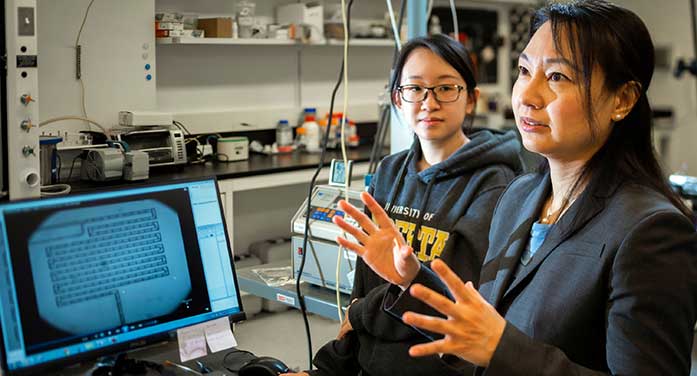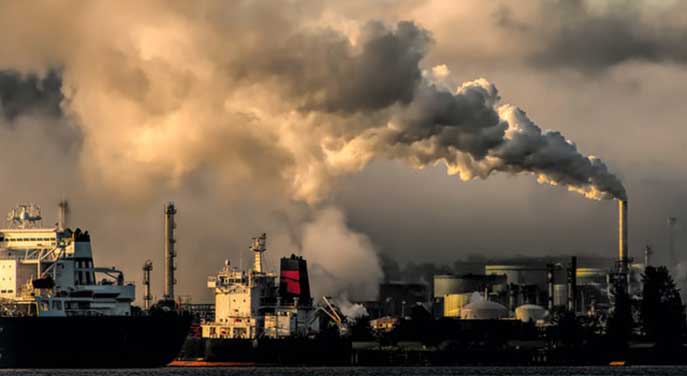
Engineering professor Amy Tsai (right) speaks with graduate student Junyi Yang. Tsai’s research team is drilling down to the microscopic level to better understand how stored carbon behaves in salt-water aquifers deep underground. (Photo: John Ulan)
A University of Alberta researcher is working to improve how carbon dioxide is stored and absorbed when it’s pumped underground for safe, long-term storage.
By taking an up-close look at the processes of carbon capture and storage (CCS), Amy Tsai, a professor in the Faculty of Engineering, is getting a better idea of how CO2 is transported and dissolved in deep underground saline aquifers – natural geological formations of porous rocks filled with salty water.
The brine-filled basins store and eventually absorb the CO2 as part of the rocks over decades, helping mitigate atmospheric emissions. Saline basins, already being used in Alberta and Saskatchewan, hold massive potential for CCS, said Tsai, noting that the underground formations can store millions of tonnes of carbon dioxide per year.
But there’s still much to be discovered about exactly how much CO2 can be injected at a given site and how quickly, she added.
“Having that data is crucial for assessing suitable CO2 storage sites and for successful computer calculations for CCS processes,” said Tsai, whose work is part of Future Energy Systems, a cross-disciplinary research and teaching network at the U of A working to develop innovations for energy transition.
To get more accurate measurements, Tsai’s lab is breaking new ground, exploring at a very small scale how the CCS process works when the CO2 is injected underground at the supercritical, or heated, high-pressure stage.
Pushing the CO2 to that stage is a necessary part of carbon capture and storage. However, supercritical CO2 – with liquid-like density and gas-like viscosity – is difficult to visualize at pore scales.
Using microscopes and high-speed imaging and mimicking the same conditions as a deep saline aquifer, Tsai’s lab is capturing the dynamics of how CO2, once it is underground, dissolves and transfers into water and saline.
“We’re looking at how much and how fast CO2 can be stored in the brine at a small scale, comparable to factors such as how porous the rocks are.”
The research allows the rock pores to be closely viewed for any impurities, such as salt crystals, that could block the way and hinder the injection of the CO2.
“We’ll now be able to see the whole process in a very clear way, and this will help determine a storage rate that will let us know how fast and at what volume we can transfer and store carbon dioxide at a particular site.
Why Canada should embrace carbon-capture projects by Tom Olsen
Carbon capture is key to reaching net zero emissions by 2050
“That knowledge will help give resource companies a better idea of their capacity for carbon transfer and storage.”
Tsai’s work also explores the process of using CO2 in enhanced oil recovery, which consists of injecting carbon dioxide underground while the oil is pumped out.
Using additives such as foam, polymers and nanoparticles, Tsai and her team hope to shed light on how CO2 interacts with the substances to displace thick, sticky oil and ultimately extract more.
“We will carry out experimental measurements to figure out how much supercritical CO2 can extract the viscous oil and if other additives are beneficial for the oil recovery process.”
The research results are important for oil and gas companies seeking new ways, knowledge and data on how to extract more oil using supercritical CO2, using some helpful additives, while mitigating emissions, Tsai added.
Since beginning its research in 2017, Tsai’s team has published scientific papers on some of their pioneering findings, including detailed insights into how salt crystals block pores, how CO2 transports at pore scales and how CO2 dissolves in fluids in a supercritical state.
“Some of our observations are unique for the first time, specifically for supercritical states, and that’s exciting. This technique we are developing opens a lot of doors to other potential CO2 and microfluidic applications, as well as chemical engineering processes.”
Tsai’s work is funded by her Canada Research Chair in Fluids and Interfaces, the Natural Sciences and Engineering Research Council of Canada and Future Energy Systems.
| By Bev Betkowski
Bev is a reporter with the University of Alberta’s Folio online magazine. The University of Alberta is a Troy Media Editorial Content Provider Partner.
The opinions expressed by our columnists and contributors are theirs alone and do not inherently or expressly reflect the views of our publication.
© Troy Media
Troy Media is an editorial content provider to media outlets and its own hosted community news outlets across Canada.

